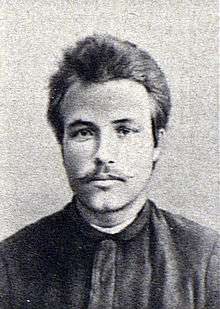Vladimir Smirnov (politician)
Vladimir Mikhailovich Smirnov (1887 – 26 May 1937) was a Russian Communist and member of the Bolshevik Party (from 1907), where he advocated a militant and doctrinally pure line.

Smirnov, who was closely associated with Nikolai Bukharin, was a political commissar in the Red Army and represented the Left Socialist-Revolutionary Party and was the main spokesman[1] of the Military opposition of 1919. He was a member of the editorial board of Kommunist, the organ of the Petrograd Committee of the party. Years before the October Revolution he pushed for a more militant party tactics, much to the annoyance of Lenin. He became the financial director of the governing body of the Moscow oblast, Sovnarkom, which exercised wide powers and had high ambitions of local rule, although it was abolished as early as June, 1918. His attempts at forming similar bodies proved short-lived.[2]
Smirnov served in the governing bureau of the Supreme Economic Council, set up in December 1917. His Left fraction initially dominated the Council and Lenin had to take their position into account.[3]
1919
At the 8th Party Congress of the Russian Communist Party, Smirnov appeared as a delegate from the 5th Army. On 20 March 1919, Smirnov gave a speech to the Congress on the use of former Tsarist officers (termed "Specialists" within the party) and of political commissars in the Red Army. Responding to accusations from Grigory Sokolnikov that he opposed the use of officers, which by this point had become a key part of Bolshevik military strategy, he denied favouring the use of partisan militias in the Russian Civil War. He did, however, warn of the inadequate political mechanisms that the Soviet authority had at its disposal to control the officer-specialists. Arguing for the repeal of Decree on Revolutionary Military Councils, he said to the Congress:
...The role of the political commissars is limited to the functions of supervision... Now that we have the political commissars with sufficient combat experience and able not to intervene when not needed, we must give them broader rights, a larger part in the direction of the armies.
Smirnov regarded the commissars as an integral check on the potential disloyalty of the old-régime officers. This preference for so-called "politicisation" of the Red Army was shared by the Left Socialist-Revolutionary Party in opposition, but largely rejected by Leon Trotsky, the People's Commissar of Army and Navy Affairs, who by 1919 exercised full control over the military. But in April 1919 the Central Committee of the RKP appointed Smirnov as the first organiser for ChON volunteers to support the Red Army in the civil-war effort.[4]
Opposition, prison and death
In 1923 he belonged to those who signed The Declaration of 46. In 1926 Smirnov, together with Timofei Sapronov, formed the "Group of 15", which joined the United Opposition headed by Trotsky, Grigory Zinoviev and Lev Kamenev. They were expelled from the Communist Party at the 15th Party Congress in December 1927 along with the rest of the United Opposition. Later, on 31 December 1927 he was arrested and sentenced to expulsion from Moscow to the Ural region for 3 years. On 29 January 1930, he was sentenced again, for 3 years in prison. On 10 November 1932, the term was extended with 2 years. And on 4 November 1934, he was sent for 3 years in Siberia. After the assassination of Kirov, in March 1935, Smirnov was arrested again and by a special decision of NKVD from 22 May 1935, was re-imprisoned for 3 years. In early 1937, while serving in the Suzdal special prison, Smirnov sent letters to the People's Commissar of Internal Affairs Yezhov and the USSR Prosecutor Vyshinsky, protesting against his detention. On April 20 the same year, he was transferred to Moscow and, on 26 May 1937, the Military Collegium of the Supreme Court USSR under the chairmanship of V. Ulrich sentenced him to death for participating in a counterrevolutionary terrorist organization. Smirnov was shot on the same day, becoming a victim of the Great Purge.
On 16 November 1960, Smirnov was partially rehabilitated but not was fully rehabilitated until 1990.
References
-
Erickson, John, ed. (1962). The Soviet High Command: a Military-political History 1918-1941. Cass Series on Soviet (Russian) Military Institutions (3rd ed.). Routledge (published 2013). p. 47. ISBN 9781136339523. Retrieved 2014-10-28.
The opposition, which became known by the name of the Military Opposition, was compounded of Left-wing Communists and elements dissatisfied with the prevailing military policy as a whole. V. M. Smirnov led for the opposition, which demanded the widening of the scope of the responsibility of the members of the Revvoensoviet, attacked the retention of the 'military specialists', sought increased military power for the commissars and required a greater place for local Party organisations in the centrally directed political work of the armed forces.
- Timothy J. Colton: Moscow: Governing the Socialist Metropolis pp. 68, 102f.
- The decline of the Russian Revolution and the cult of the Party Archived 2014-10-29 at the Wayback Machine Revolutionary Perspectives March 1, 2003-03-01, quoting R.V. Daniels: The Conscience of the Revolution. Simon and Schuster 1960, p. 84.
-
Zakharov, A. (1927). ЧОН, Очерки по истории Октябрьской революции в Нижегородской губернии [ChON: notes on the history of the October Revolution in the Nizhny-Novgorod governorate] (in Russian). Nizhny-Novgorod. pp. 47–54.
18[:] При Центральном Комитете Партии назначить ответственного организатора этого дела тов. СМИРНОВА. [18. Designating Comrade SMIRNOV as the organiser responsible in this matter to the Central Committee of the Party.]